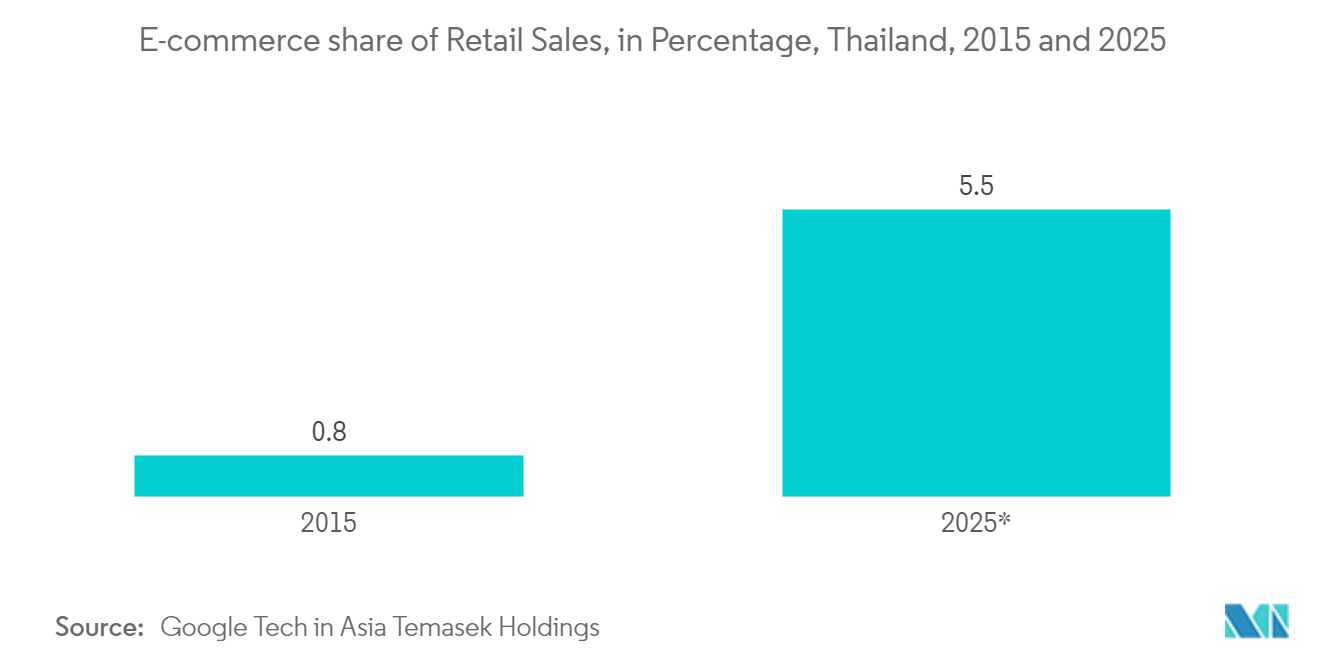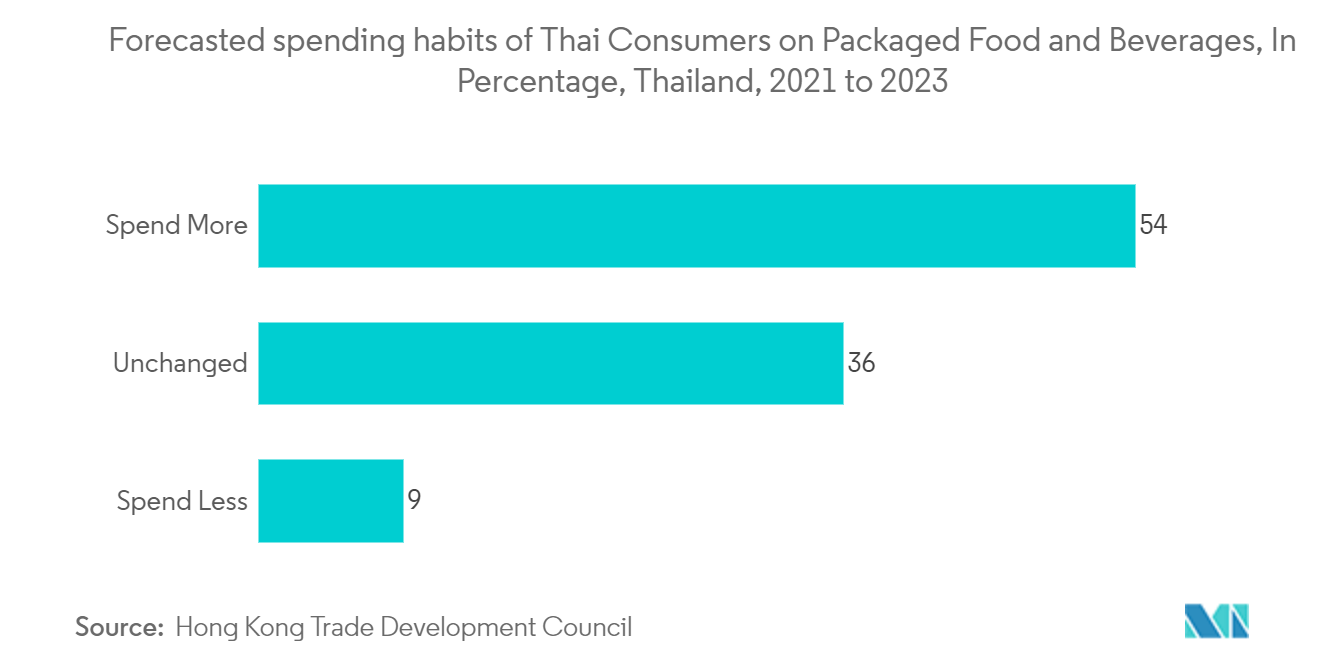Market Trends of Thailand Flexible Packaging Industry
Increased Demand for Convenient Packaging
- The increasing trend of consumer products, such as food, beverages, and pharmaceuticals, is expected to propel the demand for flexible packaging. The growing demand is attributed to the rising need for packaging solutions that are convenient and portable. The growing urban lifestyle of consumers in Thailand has been driving the demand for packaged convenience food. Convenience stores are gaining importance for Thais amid the country's urbanization and look set to remain a key channel for manufacturers to target.
- Thailand's urban population comprises more than half the total population, nearly 53% in 2022. (Source: Knoema Corporation) These urban consumers are showing an increasing propensity for convenience, high-quality brands, smaller shops, stores, and supermarkets near their workplaces or transportation routes, primarily to purchase daily necessities. The trend of the shift to flexible packaging to avail the benefits of convenience packaging and changing lifestyles, along with the growing smaller households, is increasing the need for single-serve options.
- Packaging manufacturers in Thailand are consistently moving towards sustainable developments and lightweight, convenient options for packaging. In July 2022, Ecolean, a global packaging supplier, recently demonstrated success in Thailand, with new customers launching Ecolean's lightweight, flexible packages. Ecolean has struck a golden position combining both sustainability and distinction, as Thai consumers desire more sustainable practices and packages with less environmental impact.
- Many industries have experienced progressive benefits since the adoption of lightweight packaging, and several packaging production companies are attempting to embrace it because, in addition to its primary benefits of lightweight and recycling efficiency, this type of packaging can reduce overall costs and save energy during production and transportation. In particular, the food and beverage, pharmaceutical, and cosmetics industry is attempting to stock shelves with lighter products by experimenting with various packaging materials and procedures.
- Customers across Thailand are getting more at ease with internet shopping and appreciate its convenience. The human drive for instant gratification drives faster e-commerce delivery services and convenient and lightweight packaging. Simplistic flexible packaging eliminates the effort of opening the box and reduces unneeded packaging material. Frustration-free packaging often incorporates a minimalistic approach with basic yet effective designs that make it easy to open and discard. According to Google, Tech in Asia, and Temasek Holdings, e-commerce sales made up 0.8% of total retail sales in Thailand in 2015, and this figure is predicted to rise to 5.5% by 2025.

Food Industry to Witness a Robust Growth
- Thailand's exposure to international cuisine (prepared/processed) altered consumer lives, especially views towards food and consumption habits. Food demand in Thailand has switched to processed and packaged ready-to-eat meals marketed mostly in hypermarkets and convenience stores. The need for pouch packaging for the food service sector is expanding, as it is progressively replacing traditional materials like paperboard, metals, and glass due to its advantageous qualities such as lightweight and low cost.
- Flexible packaging improves product sustainability by extending shelf life and offering new advancements in frozen meals while lowering spoiling. The market is seeing a paradigm shift in customer affinity towards frozen meals, which is boosting demand for the studied category even higher. These changes are happening partly because people spend more on higher-quality food goods. According to Hong Kong Trade Development Council, as per a study on forecasted Thai consumer spending habits on packaged food and beverages in Thailand from 2021 to 2023, 54% of the respondent confirmed that they would spend more on packaged food and beverages in the forecast period.
- Rapid urbanization is fueling the expansion of Thailand's frozen food sector. Furthermore, the growing trend is predicted to encourage international tourists, enhancing demand for frozen items. Long-term demand for frozen meats, poultry, and seafood is projected to grow due to increased demand for processed and ready-to-eat choices and expansion in domestic retail stores. According to Knoema Corporation, Thailand's urban population was 52.9% in 2022. Thailand's urban population has increased significantly during the last 50 years, rising from 22.6 to 52.9% annually.
- Food plastic wrap, also known as cling film, food wrap, and saran Wrap, is a thin plastic film that is frequently used to seal packages and keep food goods fresh in containers. Food plastic wrap is available in individual rolls or, more commonly, in boxes with a roll attached that contains a cutting edge. There is a robust awareness of sustainable packaging across the country. According to the National Science and Technology Development Agency, in August 2022, a press conference was held in Bangkok to showcase food packaging films made from biodegradable plastic pellets. This invention is the result of a collaborative effort between MTEC-NSTDA, Thantawan Industry Public Company Limited, and Royal Project Foundation and is funded by the Program Management Unit for Competitiveness (PMUC).
- As per the Office of Industrial Economics (Thailand) report, the domestic sales volume of baked goods in Thailand for Bread Products, biscuits, and cakes in April 2023 were 6.49 thousand metric tons, 6.3 thousand metric tons, and 3.27 thousand metric tons, respectively. Over the past few years, Thailand has seen a significant increase in spending on bakery goods and cereal bars, short-run ready meals and coffee or hot chocolate sticks and pouches, dry foods (instant soup, gravy, and sauce packets, rice, and food mixes), snack foods and nuts, spice foods, chocolates and sweets, ice-cream novelty items, and bakery goods like cookies (biscuits), cakes, and chips., consequently increasing the demand for flexible packaging in the country.

